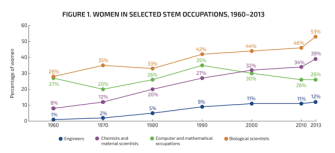
Women remain dramatically underrepresented in the fields of engineering and computing, necessitating a wide range of strategies to minimize gender bias and rethink the values and environments typically found in universities and the workplace, according to a new report from the American Association of University Women.
In 2013, just 26 percent of computing professionals and 12 percent of working engineers were women, according to the AAUW, a Washington-based nonprofit advocacy group. Those fields account for more than 80 percent of the STEM (science, technology, engineering and math) workforce—including many of the most rewarding and well-paying careers.
The group’s report, “Solving the Equation: The Variables for Women’s Success in Engineering and Computing,” cites a wide range of research indicating that it is students’ interest in STEM, not their performance in related academic subjects, that is most closely associated with their pursuit of degrees and careers in engineering and computing.
“Despite the early similarities between girls and boys in math and science achievement, by high school, boys are more likely than girls to take the standardized exams most closely associated with the fields of engineering and computing,” the report says.
In addition, first-year male college students report being three times more likely to major in engineering and six times more likely to major in computer science than their female counterparts.
After college, the AAUW researchers maintain, women are “greatly outnumbered by men in every engineering and computing discipline.” They are also “dramatically underrepresented” in those fields in the workforce and more likely to leave those fields than their male counterparts.

The numbers are particularly sobering for women of color: In 2013, Black, Hispanic, American Indian, and Alaska Native women comprised 18 percent of the population ages 20-24, but were awarded just 6 percent of computing and 3 percent of engineering bachelor’s degrees conferred that year.
Men from those racial and ethnic groups were not nearly so underrepresented.
The AAUW recommends that employers and universities address a range of “structural and cultural barriers” to greater female involvement in computing and engineering, including promoting computer science classes and research opportunities for all students; removing gender information from job-candidate evaluations; emphasizing gender diversity as a goal and holding managers accountable; and making engineering and computing more “socially relevant” by incorporating “communal values” (perhaps through more project-based learning that occurs outside the classroom and provides opportunities for solving real-life, open-ended problems.)
Among the group’s specific recommendations for educators are:
- Emphasize that engineering skills and competencies are learned, not innate;
- Frame adversity as a common experience for all students;
- Teach about the effects of stereotype threat (a well-documented phenomenon in which members of a particular group can perform poorly because they feel at risk of confirming a negative stereotype about their group, by, for example, not doing well in math or science);
- Highlight the ways in which engineering and computing can help people and provide opportunities to work collaboratively;
- Provide mentoring opportunities for girls;
- Create welcoming environments via gender-neutral décor and other means;
- Provide girls with opportunities to “tinker” and build confidence in their skills.
Charts courtesy of the American Association of University Women, Solving the Equation.
See also:



